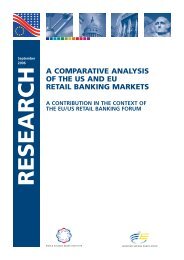Corporate Governance and Access to Finance - ESBG
Corporate Governance and Access to Finance - ESBG
Corporate Governance and Access to Finance - ESBG
Create successful ePaper yourself
Turn your PDF publications into a flip-book with our unique Google optimized e-Paper software.
Only 27 members established in 21 countries 23 answered the <strong>Corporate</strong><strong>Governance</strong> questionnaire; <strong>and</strong> complete information on <strong>Access</strong> <strong>to</strong><strong>Finance</strong> was provided by 25 WSBI members. Furthermore, data on both<strong>Corporate</strong> <strong>Governance</strong> <strong>and</strong> <strong>Access</strong> <strong>to</strong> <strong>Finance</strong> for the same institutionwere available for only nine members: Chile, Colombia, El Salvador,France, Indonesia, Peru, Philippines, Thail<strong>and</strong> <strong>and</strong> Ug<strong>and</strong>a.The following table summarizes a description on the type of informationprovided by WSBI members. A more extensive data set would haveallowed performing a more elaborated analysis on the link between<strong>Corporate</strong> <strong>Governance</strong> <strong>and</strong> <strong>Access</strong> <strong>to</strong> <strong>Finance</strong>.Table 9. Summary of WSBI members' response ratesNo. Answers <strong>to</strong>CORPORATENo. Answers <strong>to</strong>GOVERNANCE ACCESS TO FINANCE Observations onQuestionnaire Questionnaire CG & (full) A2FSavingsLoans21 countries 23% 24 48 countries 52% 25 countries 37% 9 countries 10%(27 members) (25%) 25 (54 members) (49%) (28 members) (37%) (9 members) (8%)- Developing: 17 24% - Developing: 36 51% - Developing: 17 35% - Developing: 8 11%- Industrial: 4 19% - Industrial: 12 57% - Industrial: 8 42% - Industrial: 1 5%In the absence of a more elaborated econometric exercise, a descriptivestatistic analysis has been realised. In addition <strong>to</strong> the questionnaires,other sources of information were used <strong>to</strong> better underst<strong>and</strong> crucialnational variables such as the regula<strong>to</strong>ry environment <strong>and</strong> the degreeof financial development that can influence <strong>Corporate</strong> <strong>Governance</strong><strong>and</strong> <strong>Access</strong> <strong>to</strong> <strong>Finance</strong> both at the country <strong>and</strong> at the institution level.Several alternatives have been used since, as stated before, there is noglobal <strong>and</strong> widely agreed measure of either <strong>Corporate</strong> <strong>Governance</strong> or<strong>Access</strong> <strong>to</strong> <strong>Finance</strong>. This section distinguishes between the country level(section 5.1.), <strong>and</strong> the WSBI members level (section 5.2.)23 WSBI members from the following countries replied <strong>to</strong> the questionnaire: Austria, Brazil,Chile, Colombia, El Salvador, France, Indonesia, Kenya, South Korea, Lesotho, Macau,Peru, Philippines, Spain, Sweden, Tanzania, Thail<strong>and</strong>, Togo, Ug<strong>and</strong>a, <strong>and</strong> Vietnam.24 Percentage over <strong>to</strong>tal countries with WSBI member(s).25 Percentage over <strong>to</strong>tal WSBI member institutions.76
















